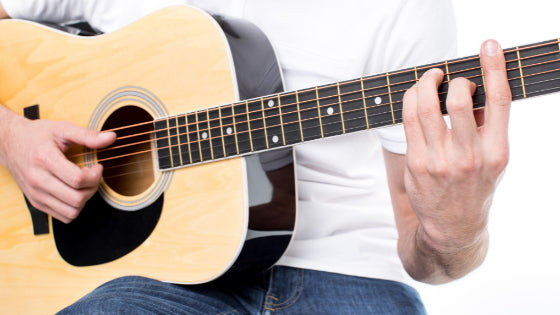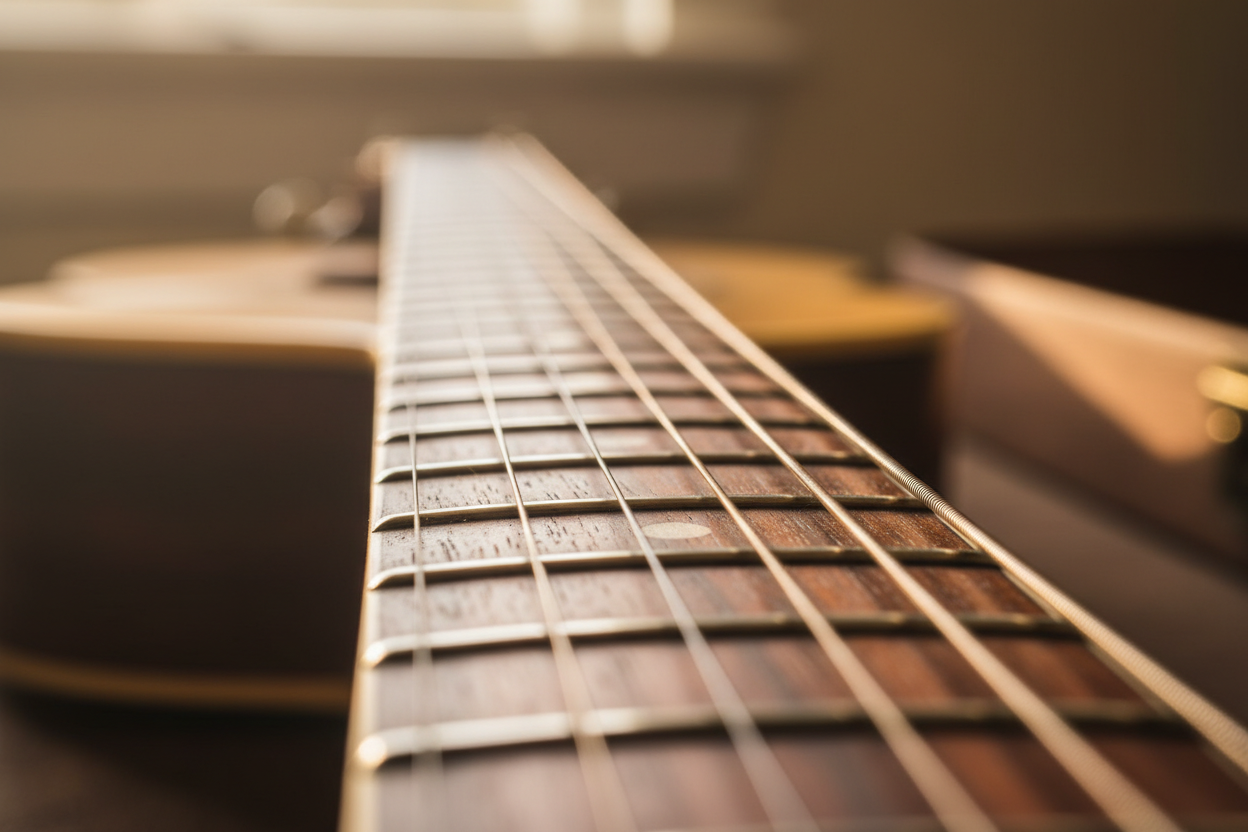Guitar Accessories for Beginners
What type of guitar accessories do you need to be a successful guitarist? If you're just starting out, you may not know. This article will show you the best guitar accessories that every guitarist should have in their arsenal. From getting a tuner – one of the first things a guitarist needs to be able to do – to effects pedals. Read on to learn about guitar accessory essentials.
Guitar Tuner

If you're just starting to learn how to play the guitar, one of the first accessories you'll need is a guitar tuner. Tuning your guitar can be tricky at first, but it will get easier with practice. If you tune your guitar regularly, it will also train your ear to recognize different pitches.
Many acoustic guitars come with a tuner attached or built-in, but if yours doesn't, Tuners are an indispensable and inexpensive accessory for any guitar player. They can be as simple as a clip-on tuner that attaches to the guitar headstock or as complicated as a floor pedal that supports multiple tuning modes. You can also download a free tuner app on your phone, but cellphone tuners are not as convenient as a clip-on guitar tuner.
Microfiber Cleaning Cloth

After weeks of playing guitar, your guitar will inevitably get dirty. That's why it is imperative to have a cleaning cloth that can remove dirt and smudges without scratching the guitar's finish. Never use paper towels. They might be convenient, but they are abrasive and will scratch your beautiful guitar up something fierce. Instead, find a quality microfiber cloth for keeping your guitar nice and shiny.
Pro tip: Dust off any particles with a soft brush before wiping down your guitar. Any particles could potentially scratch your guitar's finish if they get embedded in your cloth. Check your cloth before and after each use for any abrasive particles and remove them if found.
Guitar Polish
Spare Guitar Strings
There will come a day when you break a guitar string, or they become corroded and need to be replaced. Guitar strings come in a variety of gauges or thicknesses. The most common gauges are light, medium, and heavy. There are also variations within each gauge, so finding the right set for your playing style is important. For example, heavier gauge strings are generally better for strumming and chord work, while light gauge strings are better for lead work.
It is also important to choose the right string type for your guitar. Most acoustic guitars use phosphor bronze-wound strings, while electric guitars use nickel-wound strings. There are also other types of string materials available, such as steel and silk.
Be sure to keep your guitar strings clean and free of corrosion. You can clean them with a clean cloth and string cleaner.
Guitar String Cleaners
It's a good idea to have some guitar string cleaner/lubricant. You can use a string cleaner once a week or every day. The right string cleaner/lubricant will keep your guitar playing experience very pleasant. Over time, it will also save you money by extending your guitar string life. The string cleaners typically are a mineral oil formula that will help your fingers glide up and down the fretboard and reduce the noise, sometimes referred to as 'string talk' that occurs when you slide your fingers back and forth on a string. The lubricant also helps repel moisture to slow down the corrosion process, so your strings don't get rusty.
A Gigbag or a Case

A gig bag or a case is a must-have for any guitar player. It will protect your guitar during transport and is also the best place to store it when you are not playing. When a guitar case or gigbag is used with a humidifier, it will keep your guitar safe from drying out if you live in an arid climate or you happen to be heating your home in the wintertime.
The case can also help seal out excessive moisture in the humid season. You can use silicone packs to help absorb moisture in your case or use a 2-way humidifier made by D'Addario. In addition, if your guitar is electric, it will help keep dust from penetrating the controls. Dust in your tone or volume controls can cause unwanted noise or a poor signal.
Guitar Humidifier

One way to combat the adverse effects of dry air on your acoustic guitar is to use a guitar humidifier. This little device attaches to the strings at your guitar's soundhole and releases moisture that helps to keep the wood hydrated. This is important because wood that is too dry can crack and split, which can ruin your instrument. There are a few different types of humidifiers on the market, so it's important to do your research and choose the right one for your guitar.
For electric guitars, we recommend a case humidifier. Although solid-body guitars can tolerate dryness better than an acoustic guitar, they still can get damaged. The neck can warp and twist from drying out. Another issue that arises from a dry guitar neck is fret sprout. Fret sprout is when your fret edges are hanging over the edge of your guitar neck. This is a result of the neck's wood fibers shrinking. As a result, the neck reduces in its width and thickness, but the frets remain the same size because they are made of metal.
Guitar Picks

Many new guitar players don't think about the importance of which guitar pick they use. However, the type of pick you choose can make a big difference in the sound your guitar produces. There are many different types of picks on the market with varying degrees of thickness and roughness, which means you will need to experiment with them to find out what type works best for you.
An excellent place to start is a light/medium gauge variety pack so that you can experiment with some different picks. Light gauge picks are suitable for strumming and have an excellent percussive sound when attacking the strings. Medium picks can work for various styles, and heavy picks are great for speed picking. No matter how long you have been playing, you'll always be trying out new picks. Specific picks work well for certain techniques or music styles. For example, many heavy metal or jazz guitarists prefer a thick pick because it keeps its form when picking fast. This allows for a more accurate pick attack, making it easier to sync both hands together and cleanly play through scales quickly.
Metronome

Many guitar players today start without the use of a metronome. This is unfortunate because it is so useful for developing rhythm and timing. It also helps players learn how to play with other musicians. The use of a metronome will allow the player to better time their notes which will lead to more fluidity with the music they are performing. It is a must-have training tool for any musician.
Guitar Cables

If you are playing an electric guitar, you will need a guitar cable to connect your guitar to an amplifier. You want to find a decent cable that can provide a good signal and last. Always have a backup cable. Over time the solder connections in the input jacks of the cable can degrade from frequent use. You want to have a spare because someday your cable might start making static noises, or the signal intermittently cuts out, or possibly no signal at all. Spend a little extra on cables if you can afford to do so, a pro-quality cable will last you for many years.
Guitar Strap

Whether you’re a beginner, a hobbyist or an experienced professional, all guitarists at some point want to be able to play their guitar standing on a stage or in the practice studio. A guitar strap will hold your guitar in place so you can do just that. They also serve as an extension of your style and personality. There is an abundance of different straps on the market that finding one that's right for you is easy.
No matter what type of strap you choose, be sure to get the right length. You don't want the strap to be too long or too short. A guitar strap should be adjustable to fit the player so that the guitar is at a comfortable playing height.
Guitar Stands

Guitar stands are great for displaying your guitar. They also make it easier for your to pick up and start playing. Consequently, having a guitar on a stand can result in more practice because of its convenience. There are various guitar stands to choose from, so be sure to select the one that best meets your needs. You have to be careful in choosing the right one because it will be holding your precious instrument. We will recommend a few different types of stands available and then give you a few tips on choosing the right one for you.
The first type of stand is the Tripod Stand. This stand is affordable and can be used on acoustic and electric guitars. It's stable if used on a level surface. It has a rubberized cradle that will protect your guitar from scratches. It's also portable so you can take it with you wherever you go. But a word of caution, your guitar can easily topple over if you bump it while using this type of stand. Always use the cradle strap to minimize the chance of your guitar falling off the stand. Be sure to have the stand on a level surface, or your guitar could shift away from the stand and fall over. This type of stand is very popular because of its low price, but in the end, it can cost you a lot in repairs if not used very carefully.
The second type of guitar stand is an A-frame stand. This stand is also great for both acoustic and electric guitars. It's very stable and can hold guitars of all shapes and sizes. The A-frame stand is also very portable and easy to set up. They usually are priced between $20 and $30, an affordable investment to keep your guitar secure.
The third type of stand is a tripod in which the guitar hangs from the cradle. This type is very stable because the guitar cannot be accidentally knocked off the stand. It would take a significant bump to topple this stand. It's an excellent stand to have if you have pets or kids that might bump into your guitar.
You can also buy stands that can hold 3 or 5 guitars at a time. These stands usually are very stable and save you space. Now that you know about the different types of guitar stands, how do you choose the right one for you? Here are a few tips:-Choose a stand that is stable and will not fall over easily.-Choose a stand that is easy to set up and take down.-Choose a stand that fits your guitar size and shape.-Choose a stand that is portable so you can take it with you wherever you go.
Your safest option, if installed correctly, is the Wall Hanger. This type of display is perfect if you don't have a lot of space or if you want to show off your guitar. It hangs on the wall and takes up very little space. It's also very sturdy and can hold a variety of guitar sizes.
One thing needs to be mentioned if you store your guitar on a stand. You should monitor the room's humidity levels where you have your guitar kept. A 50% relative humidity is the sweet spot for storing guitars and keeping them playing at their best. Of course, this humidity level is easier to maintain when you store your guitar in a case, but if you want to keep your guitars on display with a stand or hangers, we highly suggest buying a whole-house-type humidifier to safeguard your instruments.
Guitar Pedals

Guitar pedals are important in shaping your sound and tone while playing the guitar. There are a variety of guitar pedals on the market, each with its unique capabilities. When choosing a pedal, it's essential to consider what type of sound you're aiming for and what kind of music you play. Some pedals are designed for specific genres of music, such as metal or blues. Other pedals are more versatile and can be used for various styles. It's important to try out different pedals and see what works best for you. Popular guitar pedals include the distortion pedal, the fuzz pedal, and the delay pedal. The distortion pedal is used to create a heavier sound, while the fuzz pedal adds a distinctive sound that is often used in psychedelic rock music. The delay pedal creates an echoing effect that can create depth in your sound. There are also wah-wah and phaser pedals, which are used to create unique sounds that can be used in various styles. The wah-wah pedal creates a vocal-like sound, while the phaser pedal creates a swirling effect. When choosing a pedal, it's important to experiment and find the pedals that work best for you. There is a wide variety of pedals available on the market, so take your time and find the ones that fit your style.
Capo

A capo is a device used to raise the pitch of the strings of a fretted instrument like the guitar. This can allow easier finger placement and make playing much less of a stretch for the hands; therefore, it is an excellent tool for learning new chords.
But the main benefit of the capo is to change the guitar's key. You can still use the same chord shapes, but your key changes because you are playing them in a different position on the neck. For example an open E chord shape played with a capo at the 3rd fret becomes a G chord. It still looks like the E chord you learned, but in its new position, the notes have changed, resulting in an open E form chord comprised of the notes that make up the G chord.
There are different types of capos available on the market, so it is important to choose the right one for your playing style. The two most popular types are the "spring-loaded" capo, which clamps onto the strings like a clamp, and the "strap-on" capo, which wraps around the neck of the guitar.
Practice Amp

There are a variety of practice amps on the market, so it's important to choose one that's right for you. Some amps are designed for beginners, while others are more advanced. It's also important to consider the type of music you want to play.
If you're looking for an affordable amp that's perfect for everyone, check out the NUX Mighty Lite.
Conclusion
We hope this blog was able to help you understand the importance of guitar accessories. This information can help you make the right choices with gear, and get the most out of the music that you love! If you liked this blog post, please share it with your friends on social media or music forums! We would love to hear your feedback on this post.




